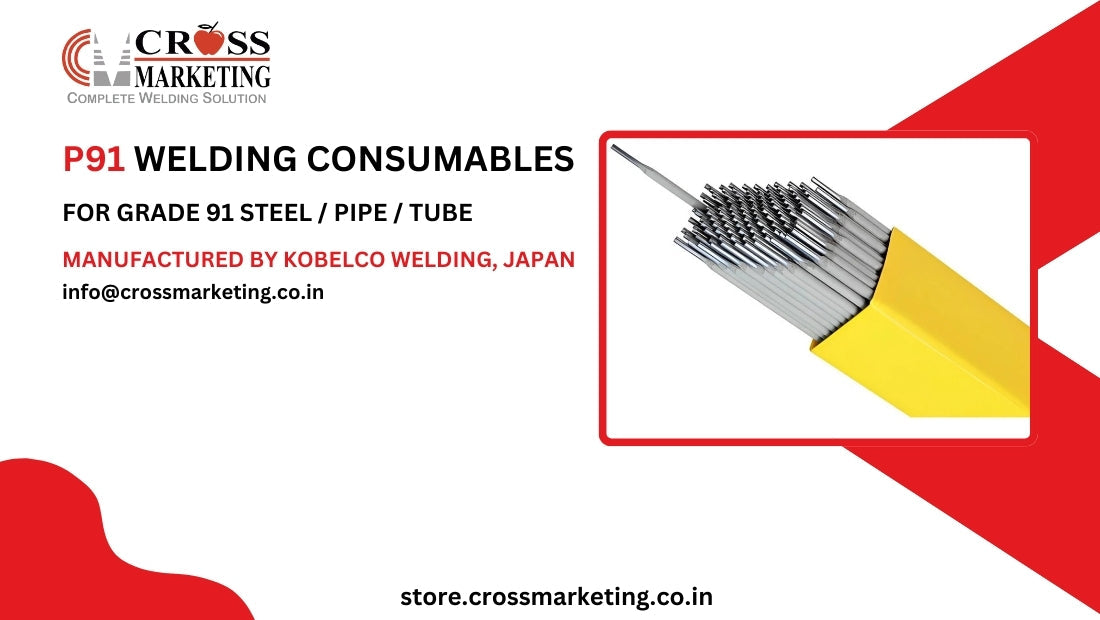P91 WELDING CONSUMABLES FOR P91 STEEL MANUFACTURED BY KOBELCO WELDING, JAPAN
1.Preface.
The main focus in thermal power generation is how to reduce CO2 emissions. To reduce CO2 emissions, there is requirement for enhancing the efficiency of power plants. Thermal power generation plants necessitate specific steels capable of withstanding prolonged exposure to high temperature and pressure steam conditions. These steels, like high chromium (Cr) ferritic heat-resistant steels containing 9-12% Cr, are essential. KOBE STEEL, LTD. (KSL) has developed and introduced B91 Series consumables tailored for welding Grade 91 (Gr. 91) steels.
A notable concern for welding pf P91 Steel is Mn+Ni, which has increasingly become a focus point. International standards organizations like ASME and AWS have begun to address this issue. The P91 Welding consumables includes Welding Electrode (SMAW), Filler Wire (GTAW), Mig Wire (GMAW), FCAW developed by Kobelco Welding, in accordance with these concerns, will be discussed as products corresponding to the AWS standards
2 International standards.
In recent years, international standards bodies have moved to continuously modify requirements for both the Mn+Ni content and the post weld heat treatment (PWHT) temperature. Tables 1 & TABLE 2 show the trends of ASME B31.1 and AWS B9/B91 standards respectively.


The tables clearly demonstrate a consistent reduction in the maximum Mn+Ni content limits across both ASME and AWS standards. This adjustment has enabled higher permissible temperatures for post-weld heat treatment (PWHT) in the welding of Grade 91 (Gr. 91) steels, crucial for reducing residual stresses post-welding.
However, exceeding the Ac1 transformation point during PWHT is known to cause fresh martensite to revert to austenite and subsequently reform as martensite during cooling. This cyclic transformation can degrade the creep resistance and toughness properties of the steel. Therefore, maintaining low levels of Mn and Ni is essential as these elements lower the Ac1 transformation temperature, exacerbating this transformation issue.
Kobelco has developed Manufacturing technology to control Mn + Ni equals to or less than 1% in all the batches and processes including Welding Electrode (SMAW), Filler Wire (GTAW), Mig Wire (GMAW), FCAW
3.Chemical compositions and Ac1 transformation point of B91 Series Welding consumables.
Initially, Kobelco introduced the B9 Series consumables tailored to meet AWS specifications. Subsequently, the B91 Series consumables were developed in 2012 to adhere to more stringent AWS requirements, particularly focusing on the increasingly strict limits for Mn+Ni content.
Table 4 illustrates the typical mechanical properties post post-weld heat treatment (PWHT) for both the 9Cb and B91 Series consumables. It demonstrates that the Kobelco P91 Series welding consumables are engineered to deliver specified mechanical properties after PWHT, with Mn+Ni content controlled to 1.0% or less. Control of Mn+Ni ensures higher PWHT temperatures can be applied.

The addition of cobalt (Co) in B91 Series consumables is another notable feature. According to Figure 2, the Ac1 transformation point tends to decrease as the combined Mn+Ni content increases. Interestingly, while Kobelco P91 Series Welding consumables do include Co, this element is unlikely to impact the Ac1 transformation point significantly. This observation holds true even for consumables without Co, where the Ac1 transformation point also decreases with higher Mn+Ni content.
Furthermore, Co primarily enhances the formation of an alternative ferrite structure. Apart from its influence on the Ac1 transformation point, the structure of welds is another crucial consideration.
4.Mechanical properties of B91 Series consumables.
Figure 6 shows the creep rupture properties of CM-95B91 and TG-S90B91.

It has been verified that these P91 Welding Electrode (SMAW), Filler Wire (GTAW), Mig Wire (GMAW), FCAW consumables exhibit superior creep rupture properties compared to butt joint welds (indicated by the dotted line), even under post-weld heat treatment (PWHT) conditions as high as 780°C.
Testing is currently underway to evaluate the creep rupture properties of these consumables under extended conditions, specifically at 600°C and 100 MPa. For instance, CM-95B91 and TG-S90B91 have already exceeded 60000 Hours of testing, respectively.
6. Usability of the B91 Series Consumables
The usability of B91 Series consumables has been significantly enhanced. When manufacturing covered electrodes for Shielded Metal Arc Welding (SMAW), Kobelco Uses alloy core rods are typically employed to maintain consistent quality of alloying elements in welds of high-chromium ferritic steels. However, electrode burn issues are common, especially with Direct Current (DC) welding. CM-95B91 manufactured by Kobelco is specifically engineered to minimize electrode burn and can operate effectively at higher welding currents.
In Submerged Arc Welding (SAW) applications for high-chromium ferritic steels, a specific problem involves slag adhering to the weld bead surface, commonly referred to as burnt slag. This issue has been mitigated with B91 wire combined with an enhanced flux formulation. Figure 7 illustrates the comparison of weld bead appearances between SAW using the P91 wire with the improved flux and traditional flux. Clearly, the improved SAW flux significantly reduces the presence of adhesive slag on the weld bead surface.
Improved SAW flux

6. NOTES ON USAGE .
Due to their high chromium-ferritic composition, weld metals produced by Kobelco P91 Welding consumables exhibit significant self-hardening characteristics compared to those used for 1.25Cr-0.5Mo and 2.25Cr-1Mo steels. Consequently, they also demonstrate increased susceptibility to delayed cracking. Therefore, precise control of welding procedures is crucial. Properly managing pre-heating and interpass temperatures effectively prevents delayed cracking and ensures the integrity of weld metals.
Typically, pre-heating and interpass temperatures ranging from 250°C to 350°C are recommended. Additionally, minimizing impurities such as phosphorus (P) and sulfur (S) in Kobelco P91 Series Welding consumables is essential to prevent hot cracks during welding.
Given the higher susceptibility of B91 Series weld metals to hot cracking and a broader solid-liquid coexistence zone compared to 1.25Cr-0.5Mo and 2.25Cr-1Mo steels, welding procedures should avoid excessively high welding currents and speeds. When selecting Post-Weld Heat Treatment (PWHT) conditions, care must be given to achieving the required tensile strength and notch toughness properties, even when operating at elevated temperatures such as 760°C to 780°C.
7. POSTSCRIPT.
The Kobelco P91 Welding Consumable has three key attributes.
Firstly, they confirm to international standards like ASME and AWS.
Secondly, their high Ac1 transformation point allows for the application of elevated Post-Weld Heat Treatment (PWHT) temperatures.
Thirdly, they are engineered to deliver exceptional creep rupture properties even under rigorous PWHT conditions.
View Products
- Kobelco AWS A5.5 E9015-B91, CM-95B91 SMAW(Stick Electrode) P91 Welding Electrode
- Kobelco; AWS ER 90SB91; TGS 90B91; GTAW (Tig welding rod); P91 Welding Filler Wire



